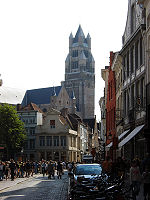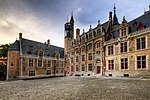Ten Wijngaerde (Begijnhof Brugge)
BeguinagesBuildings and structures in BrugesWorld Heritage Sites in Belgium

The Princely Beguinage Ten Wijngaerde (Dutch: Prinselijk Begijnhof Ten Wijngaerde) is the only preserved beguinage in the Belgian city of Bruges. There are no more Beguines living there, but since 1927 it has functioned as a convent for Benedictines, founded by canon Hoornaert. In the same year the houses at the west side were also reshaped and enlarged into the Monasterium De Wijngaard, a priory of Benedictine nuns.
Excerpt from the Wikipedia article Ten Wijngaerde (Begijnhof Brugge) (License: CC BY-SA 3.0, Authors, Images).Ten Wijngaerde (Begijnhof Brugge)
Begijnhof, Bruges Brugge-Centrum (Brugge)
Geographical coordinates (GPS) Address External links Nearby Places Show on map
Geographical coordinates (GPS)
| Latitude | Longitude |
|---|---|
| N 51.201222222222 ° | E 3.2225555555556 ° |
Address
Begijnhof Ten Wijngaerde (Begijnhof van Brugge)
Begijnhof
8000 Bruges, Brugge-Centrum (Brugge)
West Flanders, Belgium
Open on Google Maps











